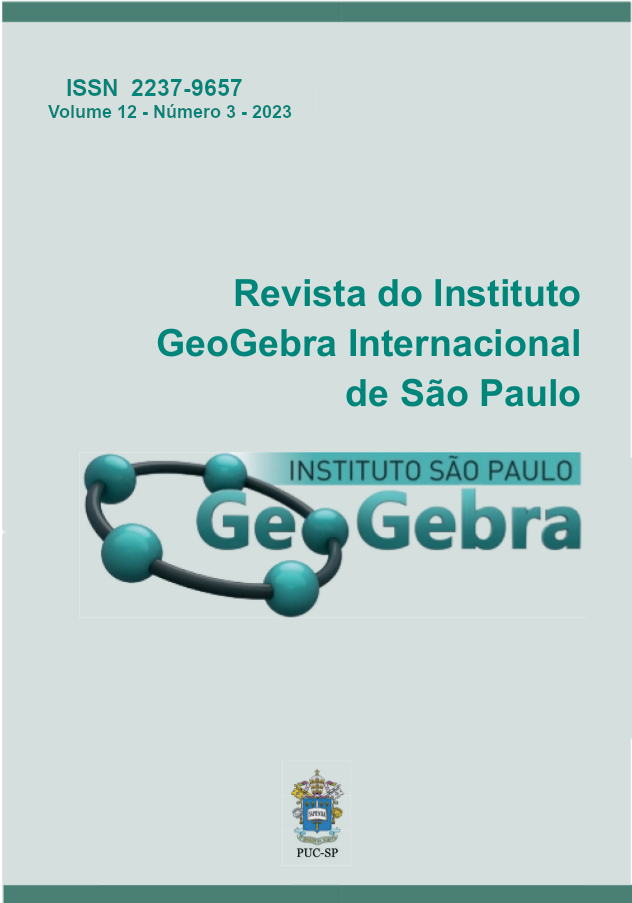Study of the quadrilaterals as geometric concepts with GeoGebra
DOI:
https://doi.org/10.23925/2237-9657.2023.v12i3p037-053Keywords:
quadrilaterals, concept learning, GeoGebraAbstract
In this article, the construction process of several quadrilaterals with GeoGebra is studied, analysing, then, the elements of the concepts (name, essential attributes, non-essential attributes, positive examples, negative examples and rule) corresponding to these quadrilaterals. Specifically, using the dynamic geometric environment GeoGebra, two constructions of the square, the parallelogram and the kite are explored, followed by the analysis of the elements of these concepts. In terms of the construction of the quadrilaterals and the analysis of the construction, it should be noted that GeoGebra proved to be a tool with high potential for the construction of the different quadrilaterals and the analysis of these constructions verified that the main elements of the respective concepts were applied, especially the essential attributes, which are used in the composition of the rule, non-essential attributes, and positive examples. Given such potential, it is considered that GeoGebra is a very suitable tool to explore the construction of quadrilaterals and promote the learning of concepts.
References
Crowley, M. L. (1987). The van Hiele Model of the Development of Geometric Thought. In Mary M. Lindquist, & Albert P. Shulte (Eds.), Learnig and Teaching Geometry, K-12 (1987 Yearbook, pp. 1-16). Reston, VA: NCTM.
Dias, & A. Osório (Eds.), VI Conferência Internacional de TIC na Educação: Challenges 2009 (pp. 873-885). Braga: Centro de Competência da Universidade do Minho.
Fernandes, J. A. (2022). Operar com números positivos no GeoGebra: implicações didáticas. Revista do Instituto GeoGebra Internacional de São Paulo, 11(2), 72-91.
Fernandes, J. A., & Viseu, F. (2006). Implicações das novas tecnologias para o currículo de matemática. In A. F. Moreira, J. A. Pacheco, S. Cardoso, & A. C. Silva (Orgs.), Actas do VII Colóquio sobre questões curriculares – III colóquio luso-brasileiro. Globalização e (des)igualdades: os desafios curriculares (pp. 993-1007). Braga: Centro de Investigação em Educação da Universidade Minho.
Fernandes, J. A., Alves, M. P., Viseu, F. & Lacaz, T. M. (2006). Tecnologias de informação e comunicação no currículo de matemática do ensino secundário após a reforma curricular de 1986. Revista de Estudos Curriculares, 4(2), 291-329.
Joyce, B., & Weil, M. (1996). Models of teaching. Boston: Allyn and Bacon.
Junqueira, M. (1996). Exploração de construções geométricas em ambientes computacionais dinâmicos. Quadrante, 5(1), 61-108.
MEC (2018). Base Nacional Comum Curricular ─ Educação é a Base. Brasília: Ministério da Educação.
Ministério da Educação (2018). Aprendizagens Essenciais de Matemática: Ensino Secundário. Lisboa: Autor.
Ministério da Educação (2021). Aprendizagens Essenciais de Matemática: Ensino Básico. Lisboa: Autor.
Moreira, M. A., & Buchweitz, B. (1993). Novas estratégias de ensino e aprendizagem: os mapas conceptuais e o Vê epistemológico. Lisboa: Plátano Edições Técnicas.
Novak, J. D., & Gowin, D. B. (1996). Aprender a aprender. Lisboa: Plátano Edições Técnicas.
Skemp, R. R. (1993). The psychology of learning mathematics. Hillsdale: Lawrence Erlbaum Associates.
Viseu, F., Fernandes, J. A., Fernandes, M. C., Faria, M. S., & Duarte, P. (2009). Os mapas de conceitos na aprendizagem de Estatística por alunos do 10.º ano do ensino profissional. In P.
Downloads
Published
How to Cite
Issue
Section
License
Copyright (c) 2023 Revista do Instituto GeoGebra Internacional de São Paulo

This work is licensed under a Creative Commons Attribution 4.0 International License.
Submission, processing, and publication of articles sent to the journal and registration of the DOI at Crossref is free of charge.
Authors retain their copyright and grant the journal the right of first publication of their article, which is simultaneously licensed under a Creative Commons - Attribution 4.0 International license CC BY that allows others to share the article by acknowledging its authorship and initial publication by the journal.
The GeoGebra journal encourages its authors to register their work with information and communication management systems aimed at researchers, such as Academia.edu, Mendeley, ResearchGate, etc.


 10.23925
10.23925
